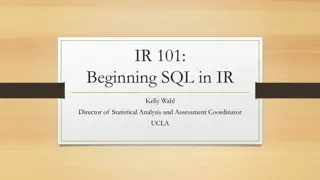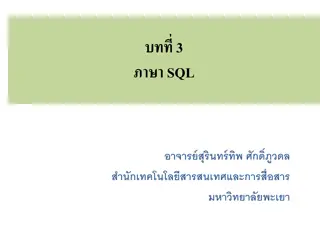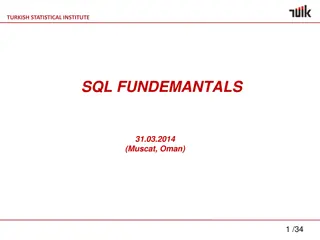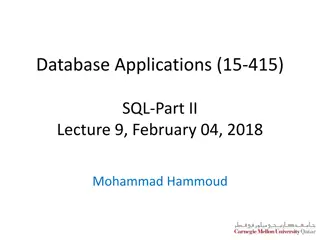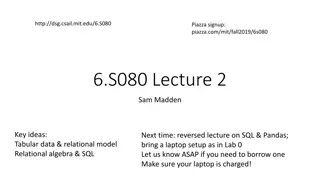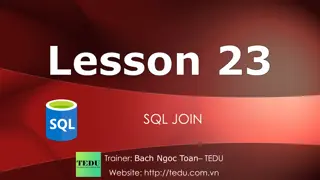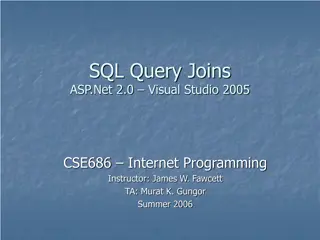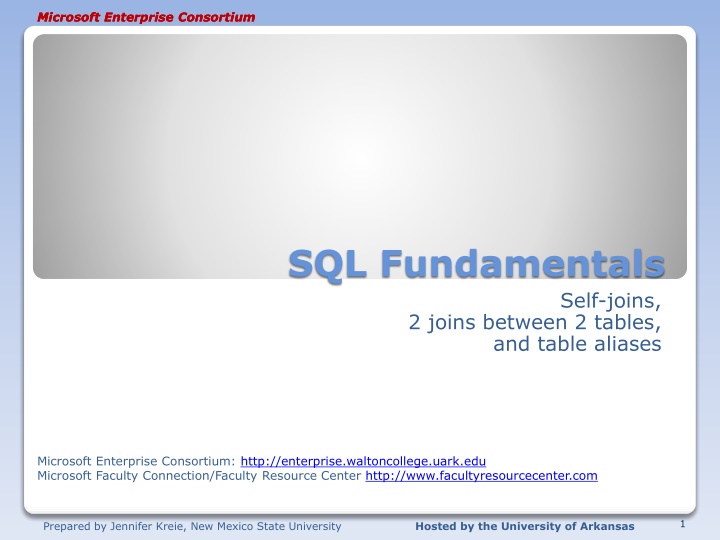
SQL Fundamentals: Self-Joins, Table Aliases, and Unary Relationships
Learn about self-joins, table aliases, and unary relationships in SQL fundamentals. Understand how to create self-joining tables and the relationships between them. Explore examples and gain insights into querying related data efficiently.
Download Presentation

Please find below an Image/Link to download the presentation.
The content on the website is provided AS IS for your information and personal use only. It may not be sold, licensed, or shared on other websites without obtaining consent from the author. If you encounter any issues during the download, it is possible that the publisher has removed the file from their server.
You are allowed to download the files provided on this website for personal or commercial use, subject to the condition that they are used lawfully. All files are the property of their respective owners.
The content on the website is provided AS IS for your information and personal use only. It may not be sold, licensed, or shared on other websites without obtaining consent from the author.
E N D
Presentation Transcript
Microsoft Enterprise Consortium Microsoft Enterprise Consortium Microsoft Enterprise Consortium SQL Fundamentals Self-joins, 2 joins between 2 tables, and table aliases Microsoft Enterprise Consortium: http://enterprise.waltoncollege.uark.edu Microsoft Faculty Connection/Faculty Resource Center http://www.facultyresourcecenter.com 1 Prepared by Jennifer Kreie, New Mexico State University Hosted by the University of Arkansas
Microsoft Enterprise Consortium Microsoft Enterprise Consortium What you ll need Log in to MEC for this lesson and into MSSMS (Microsoft SQL Server Management Studio). Be sure to select your account ID under Database in the Object Explorer pane, similar to the example shown here. If there is something besides the self-join and table alias topics that you re not familiar with in this presentation, please review earlier lessons in this SQL Fundamental series. 2 Prepared by Jennifer Kreie, New Mexico State University Hosted by the University of Arkansas
Microsoft Enterprise Consortium Microsoft Enterprise Consortium Self-joins A unary relationship occurs when an entity (table) is related to itself. This is not that unusual in a database, by the way. For this presentation we ll use the Student-Teams database and we ll also use a simple one-table example created just for this lesson. EMPLOYEE: The ERD shown here shows that the employee table has a one-to-many relationship with itself. 3 Prepared by Jennifer Kreie, New Mexico State University Hosted by the University of Arkansas
Microsoft Enterprise Consortium Microsoft Enterprise Consortium EMPLOYEE A unary relationship Why is the employee related to itself? An employee may report to another employee (supervisor). An employee may supervise zero to many employee (subordinates). In the EMPLOYEE table example, emp_ID is the primary key. Emp_Supv is the foreign key (this is the supervisor s employee ID). SELF-JOIN: If we want a list of employees and the names of their supervisors, we ll have to JOIN the EMPLOYEE table to itself to get this list. 4 Prepared by Jennifer Kreie, New Mexico State University Hosted by the University of Arkansas
Microsoft Enterprise Consortium Microsoft Enterprise Consortium EMPLOYEE Create table & insert data To prepare for the self-join, create the employee table and insert data. (The SQL script is provided to instructors.) CREATE TABLE dbo.employee( emp_ID varchar(4) NOT NULL, emp_Fname varchar(10) NULL, emp_Lname varchar(10) NULL, emp_Supv varchar(4) NULL, CONSTRAINT PK_employee PRIMARY KEY(emp_ID) , CONSTRAINT FK_supervisor FOREIGN KEY(emp_Supv) REFERENCES employee(emp_ID)); Insert data. insert into employee (emp_id, emp_fname, emp_lname, emp_supv) values ('1050', 'Carlo', 'Mora', NULL); insert into employee (emp_id, emp_fname, emp_lname, emp_supv) values ('1077', 'Carla', 'Stevens', 1050); insert into employee (emp_id, emp_fname, emp_lname, emp_supv) values ('1062', 'Robert', 'Block', 1050); insert into employee (emp_id, emp_fname, emp_lname, emp_supv) values ('1080', 'Wilma', 'Washington', 1050); insert into employee (emp_id, emp_fname, emp_lname, emp_supv) values ('1063', 'Teresa', 'Roberts', 1062); insert into employee (emp_id, emp_fname, emp_lname, emp_supv) values ('1081', 'Rory', 'Block', 1062); 5 Prepared by Jennifer Kreie, New Mexico State University Hosted by the University of Arkansas
Microsoft Enterprise Consortium Microsoft Enterprise Consortium EMPLOYEE data If you look at the employee data, you can figure out that Robert Block s supervisor is Carlo Mora. Carla Stevens and Wilma Washington also report to Carlo Mora. Select * from employee; How can we get the list of employees and their supervisors? 6 Prepared by Jennifer Kreie, New Mexico State University Hosted by the University of Arkansas
Microsoft Enterprise Consortium Microsoft Enterprise Consortium Using EMPLOYEE twice in a query. We will use the EMPLOYEE table twice in the query. In order to do this we have to rename the table give it an alias. When we list the table in the FROM clause the table name is immediately followed by the table alias. We ll use sub (subordinate) and supv (supervisor). select ... from employee sub, employee supv Where ... You should decide on the aliases before typing the SELECT clause because you ll use them in the SELECT clause. select sub.emp_id as "Sub ID", sub.emp_fname + ' ' + sub.emp_lname as "Subordinate", supv.emp_id as "Supv ID", supv.emp_fname + ' ' + supv.emp_lname as "Supervisor" from employee sub, employee supv where sub.emp_supv = supv.emp_id; 7 Prepared by Jennifer Kreie, New Mexico State University Hosted by the University of Arkansas
Microsoft Enterprise Consortium Microsoft Enterprise Consortium Self-join output: List of employees and their supervisors. select sub.emp_id as "Sub ID", sub.emp_fname + ' ' + sub.emp_lname as "Subordinate", supv.emp_id as "Supv ID", supv.emp_fname + ' ' + supv.emp_lname as "Supervisor" from employee sub, employee supv where sub.emp_supv = supv.emp_id; 8 Prepared by Jennifer Kreie, New Mexico State University Hosted by the University of Arkansas
Microsoft Enterprise Consortium Microsoft Enterprise Consortium Another need for table aliases: Two joins between two tables The Student-Teams database has two tables with two relationships. TEAMS EVAL_ITEMS STUDENTS Evaluatee Evaluator EVAL_ITEMS_SCORES EVALUATIONS To get the names of evaluatees and evaluators, we ll need to use the STUDENTS table twice one for each relationship to EVALUATIONS. 9 Prepared by Jennifer Kreie, New Mexico State University Hosted by the University of Arkansas
Microsoft Enterprise Consortium Microsoft Enterprise Consortium Another need for table aliases: Two joins between two tables /* List evaluatees and evaluators. Show the evaluation ID, student IDs and full names. */ STUDENTS We ll use EVALUATEE and EVALUATOR as the table aliases for the STUDENTS table. Evaluatee Evaluator select eval_ID, evaluatee.stdid as "Evaluatee ID", evaluatee.stdfname + ' ' + evaluatee.stdlname as "Evaluatee ID", evaluator.stdid as "Evaluator ID", evaluator.stdfname + ' ' + evaluator.stdlname as "Evaluator ID" from students evaluatee, students evaluator, evaluations where evaluatee.stdid = evaluations.evaluateeID and evaluator.stdid = evaluations.evaluatorID order by evaluateeID; EVALUATIONS 10 Prepared by Jennifer Kreie, New Mexico State University Hosted by the University of Arkansas
Microsoft Enterprise Consortium Microsoft Enterprise Consortium What was covered Unary relationship Self-join in a query Table aliases Joining the same two tables twice in a query 11 Prepared by Jennifer Kreie, New Mexico State University Hosted by the University of Arkansas
Microsoft Enterprise Consortium Microsoft Enterprise Consortium Resources http://enterprise.waltoncollege.uark.edu/mec.asp Microsoft Faculty Connection Faculty Resource Center http://www.facultyresourcecenter.com/ Microsoft Transact-SQL Reference http://msdn.microsoft.com/en-us/library/aa299742(v=SQL.80).aspx AdventureWorks Sample Database http://msdn.microsoft.com/en-us/library/ms124659%28v=sql.100%29.aspx 12 Prepared by Jennifer Kreie, New Mexico State University Hosted by the University of Arkansas


